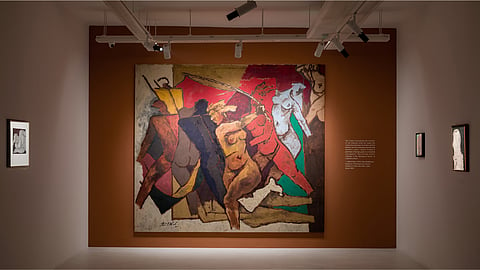
- HOMEGROWN WORLD
- #HGCREATORS
- #HGEXPLORE
- #HGVOICES
- #HGSHOP
- CAREERS
- ABOUT US
- CONTACT US

In the decades following Independence, Indian artists found themselves at the frontlines of a profound cultural transformation. Freed from the burden of colonial rule but still contending with its after effects, modern Indian art became a space for negotiating identity, nationhood, and tradition in the face of rapid social and political change.
The evolution of Indian modernism from the mid-20th century onward did not follow a coherent, homogenous stylistic, thematic, or narrative arc. Instead, it unfolded through a series of ruptures and returns — periods of intense experimentation, introspection, and reengagement with the past, tradition, and heritage. What defines this trajectory is not adherence to a formal movement, but a persistent dialogue between indigenous cultural frameworks and global modernist idioms.
The Progressive Artists' Group And Post-Independence Modernism
In the 20th century, as India gained independence from British rule, Indian artists faced a fork in the path: to break away from the academic realism propagated by colonial-era art schools, and to move beyond the nationalist revivalism of earlier movements like the Bengal School. The first group to fully articulate this shift was the Progressive Artists’ Group (PAG), formed in Mumbai in 1947 by F.N. Souza, M.F. Husain, S.H. Raza, K.H. Ara, and others.
Heavily influenced by European modernist movements — particularly Expressionism, Cubism, and Fauvism — the Progressives sought to develop a distinctly Indian modern art movement that neither imitated the West nor retreated into nostalgia. Souza's angular, often grotesque figures tackled issues of sexuality and religion, while Husain drew from folk traditions, classical Indian sculpture, and everyday life to create his dynamic, narrative-driven compositions. Raza, in later years, distilled form into abstraction rooted in Indian philosophy, most famously through his meditations on the 'bindu' or cosmic point, akin to Jorge Luis Borges' concept of the 'aleph' — an all-encompassing point that reveals the entire universe simultaneously.
Despite their stylistic differences, what united the Progressives was a belief in the transformative power of art to reflect a modern India — secular, cosmopolitan, and forward-looking.
1960s To 1980s: When The Personal Met The Political
By the 1960s and 70s, Indian modernism began to diversify and move away from the Progressive agenda. A new generation of artists pushed back against the perceived elitism and aesthetic universalism of the earlier modernists. Instead, they embraced figuration, narrative, and hyperlocal contexts. This period saw the rise of artists who used storytelling and personal experience to explore broader social and political themes.
Bhupen Khakhar, a key figure associated with the Baroda School, brought an idiosyncratic blend of intimacy, humour, and queerness into Indian art. His canvases, which drew from Indian miniatures, popular prints, and narrative painting, depicted middle-class life with startling honesty. Khakhar's embrace of autobiographical details and open expression of his homosexuality was radical in its time.
On the other hand, artists like Arpita Singh and Jogen Chowdhury developed their own visual and narrative vocabularies, often focusing on themes of domesticity, memory, and the body. Singh's densely layered canvases interspersed personal trauma with collective histories, while Chowdhury's distorted figures conveyed psychological unease and existential anxieties through his distinctive cross-hatching technique. Their work marked a shift away from formalist concerns about anatomy, composition, and colour theory toward storytelling as a mode of resistance and self-definition.
In Parallel: Folk and Tribal Modernisms
Parallel to these developments was a growing interest in the potential of indigenous art forms within the framework of modernism. While artists like Jamini Roy had earlier synthesised folk idioms with modernist aesthetics, it wasn't until the 1980s and 90s that tribal artists themselves gained prominence within the institutional art world.
Jangarh Singh Shyam, a Gond artist from Madhya Pradesh, was among the first to bring the visual language of his community into contemporary Indian art. Discovered by modernist painter Jagdish Swaminathan, Shyam adapted traditional patterns and mythologies into vibrant, large-scale works that both preserved and transformed his cultural heritage. His recognition marked an important turning point: the expansion of Indian modernism to include voices and vocabularies beyond the urban elite.
2000s to Now: Contemporary Continuities
By the 1990s and 2000s, the Indian art scene became increasingly global, with artists participating in international biennales, fairs, and auctions. Yet the questions posed by the earlier generations — around identity, modernity, and history — remained central. Artists like Atul Dodiya, Nalini Malani, and Subodh Gupta responded to liberalisation, migration, and consumerism with works that were deeply engaged with both local narratives and global art discourse.
Digital media, installation, video, and performance became increasingly common, but the fundamental concerns persisted. Contemporary Indian art continues to wrestle with the legacies of colonialism, caste, gender, and religion—frequently situating these issues within the larger context of globalisation and ecological crisis.
Indian Modern Art: Evolution Of Narratives Today
Far from being a linear journey, the evolution of Indian modern art is better understood as a series of convergences: between tradition and experimentation, personal memory and collective history, the urban and the rural, the metropoles and the marginlands. It is this richness and complexity that continues to define the modern Indian artistic imagination today.
Indian Modern Art: Evolution of Narratives, an ongoing exhibition at Art Exposure, Kolkata, surveys this multifaceted history of Indian modern art. Featuring seminal figures from the Bengal School to the Bombay Progressives, and extending to the narrative and vernacular turn in the late 20th century, the show underscores the idea that Indian modernism was never a fixed style, but a constantly evolving discourse. It brings together artists like Amrita Sher-Gil, Ramkinkar Baij, Arpita Singh, Bhupen Khakhar, and Jangarh Singh Shyam — figures whose practices expanded the definition of modern art in ways that were deeply Indian and profoundly modern.
Indian Modern Art: Evolution of Narratives is on view at Art Exposure, 16/2, Lake Terrace, Kolkata 700029 until 15 June 2025.
For more information, visit artexposure.in
Follow Art Exposure here.
